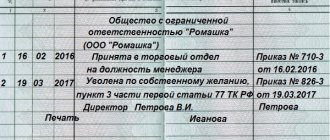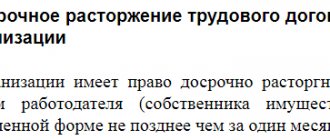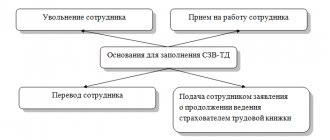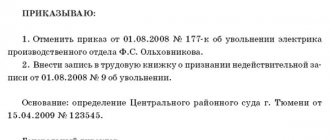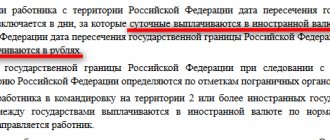The final settlement with the employee upon his dismissal implies the payment of funds that are due to the latter for the entire period of his working activity. In this case, it is necessary to take into account the grounds for termination of the contract. After all, a citizen’s salary and other necessary payments will depend on this basis. In such a situation, the manager should not forget that full settlement with the resigning person must be made on the day when the employee last carries out his activities in this organization. Otherwise, the boss simply cannot avoid problems with the law.
What operations are performed during calculation
Employees can quit for various reasons: from their own desire to staff reduction. However, payment of wages upon dismissal is carried out regardless of under which article of the Labor Code of the Russian Federation the employment contract was terminated.
The responsibility for calculating the amounts lies with the accountant, but every employee can check whether everything has been done correctly. To carry out this operation, it is necessary to request a payslip on the day of dismissal and carefully study the accruals reflected in it. After you receive the document in your hands, you can proceed to a detailed analysis of payments.
The final payment upon dismissal usually includes:
- salary for the last month of work;
- monthly bonus (if it is provided for in the employment contract);
- payment for additional work time (overtime, night, holidays, etc.);
- compensation for missed vacation.
Some enterprises have a collective agreement under which a resigning employee may be entitled to various compensation payments, especially if the contract is terminated at the initiative of the administration. This can be a one-time severance pay in a fixed amount or a percentage of the employee’s salary.
Vacation pay calculation
The company from which the employee is resigning must necessarily pay him compensation for vacation that was not used during the entire period of employment. In the case where a person has not been there for several years, the amount of payments is accordingly made for all this time. If a citizen terminates his employment relationship with an organization on his own initiative, and the period of work is not completely completed, then in this case deductions are made from his salary for the vacation used. In this case, the accounting department will have to calculate the exact number of days or months of work of the person.
The amount of vacation pay upon dismissal is calculated as follows:
- The number of days of annual paid leave is taken, for example 28. Then it is divided by the number of months in the year, i.e. 12. Then the resulting number (2.33) is multiplied by the number of months worked in the working period, for example 4.
- If you multiply 2.33 by 4, you get 9.32 unused vacation days. This number is then multiplied by daily earnings, for example 900 rubles. It turns out 8388 rubles. This is the money that a person is entitled to as compensation for unused vacation. Personal income tax will be withheld from the same amount - 13%.
The final payment to the employee should not be delayed by the boss. It must be done on time, regardless of which of the grounds specified in the Labor Code the citizen is dismissed from.
Payment terms
Calculation upon dismissal - payment terms . What is the deadline for terminating an employment contract? Regardless of the reasons for dismissal, the company is obliged to fully pay its obligations to the employee on his last day of work. Such requirements are contained in Article 140 of the Labor Code of the Russian Federation.
If the organization has a salary project, the amount due to the dismissed person is transferred to his bank card. If a company pays wages in cash, the employee receives the money from the cash register. Consequently, the calculation for the dismissal of any employee is made within the time limits specified by law.
Sometimes on the last working day an employee is absent from the workplace, for example, he is on vacation or sick. In this case, the organization is obliged to pay him the final payment upon demand on the last or next business day. If the dismissed person does not show up for the money, the funds due to him are deposited.
Payment upon dismissal of an employee is made simultaneously with the issuance of a work book and familiarization with the order to terminate the contract. This must be done on the last working day of the dismissed person.
This is also important to know:
How to write a resignation letter of your own free will
Types of payments
Regardless of the reasons for termination of the employment contract, a final settlement is required. Mandatory payments include:
- employee salary;
- compensation for vacation that was not used;
- severance pay upon termination of the relationship between the parties to the agreement under clause 2, part 1, art. 81 Labor Code of the Russian Federation.
Additional types of monetary support include: dismissal benefits by agreement of the two parties, as well as other types of material compensation established by the collective agreement.
How to calculate an employee upon dismissal: compensation for vacation
The need to calculate and pay the cash equivalent of vacation pay to a resigning employee is set out in Article 115 of the Labor Code of the Russian Federation. It states that each employee who has worked for 11 months is entitled to annual paid leave of at least 28 days.
It is not difficult to determine that for each full month an employee is entitled to 2.33 days of vacation. Based on this number, vacation pay is calculated for employees and compensation for unused vacation for those being dismissed.
Main holiday
The formula for calculating compensation looks like this:
Number of workers days = 28 days / 12 months * Number of complete work. months – Number of uses days otp.
This formula is used to calculate the employee's dismissal.
Example
Bobrov D.S. was hired as a security guard on February 1. His last working day at the company is October 31. The employee was on vacation from August 1 to August 14. 9.33 days of unused vacation are subject to compensation (28 / 12 * 10 – 14).
Free legal consultation We will answer your question in 5 minutes!
Ask a Question
Free legal consultation
We will answer your question in 5 minutes!
Ask a Question
Additional leave
Some categories of personnel are entitled to additional days of rest, for example, employees who have irregular working hours. Since additional leave is provided only after the main one has been used, when the employment contract is terminated, these days are usually unused.
This is also important to know:
Unlawful dismissal: how an employee can deal with it
To understand how additional leave is calculated when an employee is dismissed, you need to carefully study the Labor Code. The categories of personnel listed there are entitled to:
- 3 days – for specialists with irregular working hours, middle and senior managers, if the corresponding norm is in local regulations (Article 117 of the Labor Code of the Russian Federation);
- 7 days – for workers in hazardous industries (Article 119 of the Labor Code of the Russian Federation);
- in accordance with the provisions of Articles 348.10, 339, 350 of the Labor Code of the Russian Federation and industry regulations - for other categories of personnel.
Also, from 1 to 10 days, depending on length of service, is provided to civil servants of government agencies for length of service.
If the employee took a vacation in advance
If an employee took more vacation days than he was entitled to, upon termination of the contract, the accountant will have to recalculate vacation pay and withhold the excess amount paid.
The calculation procedure for dismissing an employee who has used vacation early is as follows:
1. Exclude periods from working days:
- temporary disability;
- maternity and child care leave;
- business trip days;
- being on paid or administrative leave;
- downtime due to the fault of the administration;
- days of a strike in which the quitter did not participate;
- additional days of rest (for parents of a disabled child).
2. Subtract periods not included in the vacation period - days of absenteeism, suspension from work due to alcohol intoxication (drug use), inadmissibility to work due to lack of permission from a medical worker, failure to complete safety training, expiration of a weapons license (driver's license). right).
Example of final calculation
An employee who terminates his employment relationship with a specific organization has the right to receive earned money and other compensation if the grounds for dismissal allow this. Consider the following example.
Employee Ivanov leaves the company of his own free will. Naturally, in this case he does not receive severance pay and does not receive average earnings for the third month before employment. But he has the right to payment of earned money for the entire time and compensation for vacation. The final payment to the employee in this situation will be made according to the T-61 form. This is a settlement note filled out upon termination of an employment relationship.
Ivanov wrote a statement in April and resigned on the 19th. Accordingly, he should be calculated and given remuneration for work from 1 to 18 inclusive. If his average salary is 20,000/22 working days (this is the number of them in April), the resulting amount per day is 909.09 rubles. It is multiplied by the number of days worked in the month of dismissal - 18. As a result, the amount comes out to 16363.22 - Ivanov’s salary for April. In addition, the organization first pays tax on this money, and then accountants issue the final payment to the citizen.
Since the person quits in April, but he only has scheduled vacation in June, and he did not use it, he is entitled to compensation. The calculation occurs in the following order:
Ivanov worked this year for 3 months and 18 days. But the count will be 4 full. Rounding to tenths and hundredths is not done, so the amount is calculated from 28 days of vacation/12 months a year = 2.33 days. After which 2.33*4 (months worked)=9.32 days. And only then 9.32*909.9 (daily earnings) = 8480.26 (vacation compensation).
Thus, the final payment is made from all amounts due to the employee. But in this case, this is only a salary and cash payment for vacation, because Ivanov quits on his own initiative. If he were laid off or fired due to liquidation, he would also receive severance pay, which is also paid with all funds (based on Article 140 of the Labor Code of the Russian Federation).
Average daily earnings
Any calculation of an employee upon dismissal begins with determining the amount of average daily earnings. To do this, all payments related to the wage fund are summed up. The calculation does not include:
- material aid;
- payment for study leave;
- travel compensation when sent on a business trip;
- money allocated for employee health improvement;
- funds to pay for kindergarten.
To understand how to calculate an employee’s salary upon dismissal, you can use the following rule: “The calculation of average daily earnings does not include payments already calculated based on average earnings (travel allowances, vacation pay, etc.).”
Fact
Formula for calculating average daily earnings:
Wed days charge = Salary amount. in 12 months / 12 / 29.3
The coefficient of 29.3 was introduced by Government Decree No. 642 dated July 10, 2014.
Let's give an example of how to pay an employee upon his dismissal. To do this, we will use the formula for average daily earnings.
Example
The monthly income of the seller Mikhailov E.A. for November 2021 - March was 30,000 rubles, and from April to October - 32,000 rubles each. The billing period has been fully worked out. Then the average daily earnings will be 1063.71 rubles. ((30000 * 5 + 32000 * 7) / 12).
Average daily earnings for severance pay are calculated differently. To understand how to calculate the salary for the dismissal of an employee who is entitled to severance pay, you need to divide the amount of income he received by the number of days worked according to the production calendar.
Example
Using the data from the above example, we will find the average daily earnings of E. A. Mikhailov to pay him severance pay. It will be equal to 1514.17 rubles. ((30000 * 5 + 32000 * 7) / (21 + 21 + 17 + 19 + 20 + 21 + 20 + 20 + 22 + 23 + 20 + 23)).
If you need to figure out how to correctly calculate an employee upon dismissal, you need to take into account that the days when the employee was absent from the workplace are deducted from the total amount.
Let’s assume that in January E. A. Mikhailov was sick for 10 days and earned not 30,000 rubles, but 14,000 rubles. Then his average daily earnings will be 1,510.55 rubles. (30000 * 4 + 14000 + 32000 * 7) / (247 – 10)).
Payments upon dismissal: step-by-step instructions
How to pay an employee upon dismissal? The accountant should remember that he must be extremely careful in determining the amount of payments due to the employee upon termination of the contract. After all, underpayment of the calculation is fraught with claims from the employee and inspections by the Labor Inspectorate, and overpayment threatens with an unreasonable understatement of income tax with all the ensuing consequences.
This is also important to know:
Article 33 of the Labor Code upon dismissal
Calculation upon dismissal must be made according to the following algorithm:
- Determine your earnings for the last month, taking into account all due payments.
- Calculate the amounts of main and additional leave.
- Calculate severance pay.
- Add up the received amounts.
- Withhold overpayment of vacation pay and other amounts that the employee must reimburse (if necessary).
The final amount will be the company's debt to the resigning employee.
The answer to the question of when severance pay should be paid is obvious: on the employee’s last working day. Moreover, if the resigning employee does not have a salary card, and he did not show up at the cash desk on the last working day, the amount due to him is deposited in a special account.
Rules for calculation upon termination of an employment contract
All payments due to the employee must be received on the final day of his work at this enterprise. In the event that the manager does not make the final payment at the specified time, he will bear administrative responsibility. In this case, the citizen must receive not only compensatory payments, but also the salary itself during work.
For each day of delay in payments, the manager pays a fine in the amount of 1/300 of the refinancing rate of the Central Bank of the Russian Federation. In addition, if the amount of the final settlement when paying severance pay is more than three times the employee’s earnings, then personal income tax in the amount of 13% will have to be paid on this monetary allowance. Tax is also withheld when paying vacation pay.
Calculation of severance pay upon dismissal
A one-time payment (sometimes also called compensation) is issued to an employee on the following grounds:
- if the employment contract contains a clause obliging the employer to pay severance pay in a fixed amount or based on average monthly earnings;
- upon liquidation of a company (closure of an individual entrepreneur) due to bankruptcy, revocation of a license, etc. - on the basis of the norms of clause 1 of Article 81 of the Labor Code of the Russian Federation;
- when reducing the number of personnel - according to the requirements of clause 2 of Article 81 of the Labor Code of the Russian Federation;
- when the owner of the organization changes - in relation to top management, whose dismissal occurs in accordance with the provisions of clause 4 of article 81 of the Labor Code of the Russian Federation.
The amount of payments to personnel dismissed on the grounds provided for in clauses 1-2 of Article 81 of the Labor Code of the Russian Federation is regulated by the norms of Article 178 of the Labor Code of the Russian Federation. It says that the calculation of amounts due after the dismissal of an employee must include severance pay in the amount of at least 1 month’s average earnings. If a citizen registers with the employment service within 2 weeks after termination of the contract and is unable to find a job in the next 2 months, during this period he will be paid a benefit calculated in the manner described above.
Managers and chief accountants who terminate contracts on the grounds of clause 4 of Article 81 of the Labor Code of the Russian Federation are entitled to a payment in the amount of at least 3 average earnings. They have no obligation to register with the employment service.
How severance pay is calculated: example of calculation upon dismissal
To determine the amount of severance pay, you can use the following formula:
Amount of settlement = (Amount of earnings in the calculation period / Number of days worked) * Number of days in the next months
To draw up a certificate of average daily earnings, which a dismissed employee submits to the employment service, the billing period is 3 months.
Mechanic Demidov A.S. resigns on October 31, 2019. The billing period for drawing up a certificate of average daily earnings is 08/01/2019-10/31/2019. It contains 66 working days, which are fully worked out. The employee’s income for three months amounted to 81,000 rubles. Using a calculator, we calculate severance pay upon dismissal according to clause 2 of Article 81 of the Labor Code of the Russian Federation.
For November, A.S. Demidov is owed 25,772.73 rubles. (81000 / (23 + 20 + 23) * 21). If he contacts the employment service on time and does not find a job during December 2021, the company will pay him another 25,772.73 rubles. (since in November and December 2021 the number of working days is the same - 21).
After presenting a work record book without a mark on employment, the accounting department will make a calculation upon dismissal, while the timing of payment of benefits due to A.S. Demidov will be 3 working days after the application.
Reduced severance pay
In some cases, the severance payment may be reduced to two weeks' average earnings. The reasons for this are listed in the Labor Code of the Russian Federation:
- a significant deterioration in working conditions, resulting in the impossibility of further work;
- the employee’s refusal to transfer to another job for medical reasons or the employer’s lack of a suitable vacancy;
- reinstatement of a previously dismissed employee;
- the employee’s disagreement with the employer about being transferred to another location;
- joining the army, conscription for alternative service;
- recognition of incapacity for work based on the conclusion of a medical commission.
This is also important to know:
Where to contact an employee if they are not paid wages upon dismissal
Payments after dismissal for these reasons are made on the last working day.
Increase in severance pay
Free legal consultation We will answer your question in 5 minutes!
Call: 8 800 511-39-66
In some cases, a dismissed employee may agree with the employer on more substantial compensation than he is entitled to by law. Typically, top managers manage to achieve such preferences when the company’s owners change. The amount of the agreed severance pay is usually fixed in an additional agreement to the employment contract. The terms of payment upon dismissal are also specified there.
Free legal consultation
We will answer your question in 5 minutes!
Ask a Question
It should be noted that additional agreements of this type usually contain a phrase about the absence of claims against the employer. Consequently, if the employee changes his mind, it will be almost impossible for him to challenge the amount of payments in court.
An example of calculating severance pay and other payments
Manager Shishkin A.A. is called up for military service. In this regard, he resigns from the company on November 16, 2019. The employee's salary is 26,000 rubles, monthly bonus is 3,000 rubles. The employee has been working for the company since January 2015, the pay period (November 2021 - October 2021) has been worked out in full, Shishkin A.A. has not been on vacation for the last year, so he is due 28 days of rest.
It is most convenient to calculate the employee upon dismissal, but if this is not possible, the accountant will act according to the following scheme:
- Will determine the salary for November - 13,619.05 rubles. (26000 / 21 * 11).
- Calculate the monthly premium - 1571.43 rubles. (3000 / 21 * 11).
- Find the average daily earnings - 989.76 rubles. ((26000 + 3000) * 12 / 12 / 29.3).
- Calculate compensation for unused vacation - 27,313.28 rubles. (989.76 * 28).
- Determines the amount of severance pay - 9897.60 rubles. (989.76 * 10).
- Calculate the total settlement amount - 52,401.36 rubles. (13619.05 + 1571.43 + 27313.28 + 9897.60).
The employee will receive the money after his dismissal. The answer to the question: “When should I be paid?” will be standard - no later than the last working day in the company.
Severance pay: its calculation and amount
In a situation where the employer initiates the termination of the employment relationship, the citizen has the right in a number of cases to receive compensatory benefits. It is also called a day off. In this case, the amount of this payment can be in the amount of two weeks or one month’s earnings. Cash allowance in the amount of the employee’s salary for two weeks can be in the following cases:
- If a person’s health condition does not allow him to continue working in this organization. Or when he refuses to move to another position, and the boss has nothing more to offer him.
- In case of complete loss of a citizen’s ability to work.
- If the terms of the employment contract change.
- When a person is called up for military or alternative service.
In the amount of monthly earnings, the benefit is paid:
- upon termination of an employment contract due to layoffs;
- in case of liquidation of the organization.
Also, the collective agreement may establish other circumstances when such benefits are issued to an employee. However, payment of the final payment upon dismissal, including compensatory benefits, must be made on the last day of the person’s work activity. In addition, when calculating this type of compensation, it is necessary to take into account the payment of taxes if the amount of monetary compensation exceeds the employee’s salary three times. Otherwise, personal income tax is not paid.
Required documents
The following documents serve as grounds for dismissal:
- an employee’s application for dismissal (if he terminates the contract voluntarily) or notice of termination of the employment contract;
- severance agreement.
To understand how to correctly pay settlements upon dismissal of an employee, let’s look at the list of documents that an accountant will need for this. It includes:
- dismissal order form T-8 or T-8a;
- note-calculation - form T-51;
- work record book of the dismissed person;
- personal card in form T-2.
When it is impossible to make deductions for unworked vacation
In a number of cases provided for by law, deduction for vacation upon dismissal is not made. The following situations fall into this category:
- Liquidation of the employer's organization.
- Staff reduction.
- Termination of an employment contract when a citizen is unable to perform duties due to illness.
- Conscription into the army.
- With a complete loss of previous working ability.
- Reinstatement to previous position by court decision.
- Termination of an employment contract upon the occurrence of circumstances beyond the control of the parties.
In any of the above cases of dismissal of a person, the boss must make a final settlement with him on the last day of his work and pay all funds due by law. Otherwise, the person has every right to defend his interests in the prosecutor’s office and the judiciary.
Calculation deadlines that apply when dismissing an employee in different situations
Sometimes staff quit while on vacation, sick leave, etc. Such situations often lead to an incorrect interpretation of labor legislation. Let's look at several typical cases that arise in the practice of accounting services.
How to calculate an employee if dismissal occurs after going on vacation
If an employee has written an application for leave with subsequent termination of the contract, the accounting department is obliged to calculate and pay him the salary on the last day of work (i.e. before the leave). On the same day, the personnel officer introduces the employee to the dismissal order. makes an appropriate entry in the work book and gives it to the employee.
Calculation upon dismissal on a day off: terms
If the date of dismissal falls on a weekend, payouts must be paid on the first working day following the non-working day. This follows from the provisions of Article 14 of the Labor Code of the Russian Federation.
Payment of settlement pay on a day off from the administration upon dismissal of a shift worker: deadlines
If the dismissed person works on a shift schedule and his last working day falls on the administrative staff’s day off, it is convenient for the cashier (accountant) to pay him his paycheck on a working day. Otherwise, they need to be called to work on days off, which is fraught with additional costs for paying the cashier and accountant.
This is also important to know:
Dismissal from the company by transfer: what the employee and the employer need to know about
In addition, the called employees must obtain written consent to work on days off.
Taxes upon dismissal of personnel: terms and procedure
When calculating a resigning employee, you need to keep in mind that all payments included in the payroll (salary, bonus, compensation for unspent vacation, etc.) are subject to personal income tax. However, personal income tax is not withheld from an employee’s severance pay calculated in accordance with the requirements of the Labor Code of the Russian Federation. Tax must be collected only on amounts exceeding mandatory payments.
If the payment of an employee’s salary upon dismissal occurred on a weekday, the deadline for transferring personal income tax is no later than the next working day. If the payment is made on a weekend, personal income tax is transferred on the next working day.
Procedure for issuance and retention
It is understood that all monies due must be paid to the employee. At the same time, some of them can sometimes be withheld. In a specific case, we are talking about vacation pay when an employee is dismissed for the rest that he took, but the period of work was not fully worked out, and the citizen decided to terminate his relationship with this organization and wrote a letter of resignation.
But there is one more important nuance. Money for used vacation will not be withheld by the employer from a person’s salary upon his dismissal only if his departure from work is due to staff reduction or liquidation of the organization. In this case, the employee will also have the right to severance pay in the amount of average income for two months, and if he did not get a job, then for the third month. The final payment upon dismissal of a citizen occurs on the last day of his work activity. And he is paid: salary, compensation for unspent vacation, severance pay, if applicable.
Calculation note upon dismissal: goals and design
The calculation note reflects the procedure for calculating the average daily earnings used to calculate severance pay. It does not have a regulated form; in most organizations, accountants use the T-61 form because of its clarity and convenience. The document is internal; the employee can receive it only upon a written request outlining the reasons for the request.
Purposes of receiving a note-calculation:
- control over the procedure for calculating payment amounts;
- confirmation of income at a new job (for negotiations with a potential employer);
- confirmation of the fact of illegal settlement in litigation.
Appearance and content
The T-61 calculation note contains the front and back sides.
On the front side there is information about the employee:
- Full name, position, personnel number;
- article of the Labor Code of the Russian Federation, according to the norms of which the order was issued;
- information about the date and number of the order on the basis of which the calculation is made;
- number of vacation days to be paid (or used in advance).
On the reverse side, in fact, is the calculation itself:
- monthly earnings are shown;
- the number of days of the billing period is indicated;
- average daily earnings calculated;
- the amount of vacation pay (compensation upon dismissal), the personal income tax withheld from it and the amount to be paid were calculated.
The document is endorsed by the accountant who made the calculations for the dismissed person.
Development and its accounting in the final calculation in 2019
The Labor Code of the Russian Federation provides for a 14-day working period when an employee dismisses at his own request. In cases of dismissal of an employee whose employment relationship with the employer was fixed-term, that is, concluded for a certain period, the working time will depend on the term of the employment contract. Labor contracts for a period of less than two months have a shorter working period, which is set at 3 days.
A similar three-day period is also established in the event of dismissal of an employee hired on a probationary period.
An extended service period is provided for retiring management employees. So, with directors, chief accountants, etc. The working period is one month.
Any period of service may be reduced or not applied at all if there is mutual consent of the resigning employee and the head of the enterprise. He can use his visa to shorten its duration.
Important!
Work off is full-time working time, and failure to attend it is absenteeism with all the ensuing consequences.
Conditions excluding processing are:
- Transfer of a spouse to a place of work in another locality (a summons certificate is provided);
- Admission to full-time studies (based on the enrollment order);
- Employee's first retirement. A pensioner can use this right once. In the event of re-employment and subsequent dismissal, the pensioner will be required to complete work in full if required by the management of the enterprise.
- In cases of dismissal of an employee due to the fault of the enterprise: delays in payment of wages, lack of normal working conditions, etc.
Payment for days worked is made according to general rules, in accordance with the tariff schedule, salary, etc.
What to do if payments are delayed upon dismissal, employer's responsibility
If the employer does not pay the employee in a timely manner, the dismissed person must seek help from the competent authorities. The complaint can be addressed to:
- to the labor inspectorate;
- to the prosecutor's office;
- to the district (city) court at the place of legal address of the offending organization.
The application must indicate a violation of the employee’s rights, formulate a demand for the former employer, consisting of full payment of obligations and payment of penalties for all days of delay in settlement amounts.
The following must be attached to the application:
- a copy of the work book;
- a copy of the dismissal order;
- pay slips, certificates 2-NDFL and 182-for the last 2 years;
- copies of cash receipts or payment orders for salary payments.
The labor inspectorate and the court, as a rule, side with the employee, obliging the employer to fully pay off the obligations and pay off any accrued penalties.
Arbitrage practice
Currently, many former employees are turning to court to protect their rights, which they believe were violated by the manager upon dismissal. Especially if the issue concerns cash payments that were not issued to the employee in a timely manner and in the required amount. In practice, there are even cases when employers, making payments to a citizen when reducing staff, made deductions from his income for vacation that was previously used. And this ultimately led to lawsuits and complaints.
Let's give a colorful example from practice. The employee was dismissed from the organization due to staff reduction. The boss paid him in full, but when paying the money, he made deductions for the vacation, which the citizen had already used in June. In addition, the dismissal procedure for layoffs was violated by the employer in that he did not offer available vacancies to the employee. But at the same time, he accepted other persons into vacant positions, which is prohibited when carrying out measures for dismissal on such grounds. Having counted his earned money and discovered violations of labor legislation, the former employee applied to the judicial authority with an application for reinstatement at work and payment for forced absenteeism, which occurred through the fault of his boss.
Having considered all the materials of the case, the court came to the conclusion: the employer carried out the layoff procedure without complying with the labor code. In addition, he made a completely incorrect calculation with the employee. He simply failed to make the final payment upon dismissal (2016). He grossly violated the norms of the labor code, in connection with which the citizen was reinstated in his position, and the employer paid him moral damages and compensation for the vacation used, which he had previously illegally withheld. That is why managers need to be especially careful when paying employees and avoid violations on their part, so as not to later prove their case in the courts.
Additional amounts of money due to the employee
What else may be included in the settlement with the employee? In addition to salary and vacation compensation, upon dismissal, the employer can also pay severance pay, a bonus, financial assistance, and also pay the employee’s monthly salary for the period of job search and employment in another place. However, these payments do not always occur.
- Severance pay is paid to employees upon liquidation of an organization, reduction in the number or staff of employees. The amount of severance pay is the employee’s average monthly salary, in addition, he will be paid the average monthly salary for the period of job search, but not more than two months from the date of dismissal.
The average salary for the period of employment is paid only if the employee has not found a new place. The former employee must provide supporting documents, such as a work record book, which does not contain a record of the new employer. To calculate the average monthly earnings, you need to add up the salary for all months worked, and divide the resulting number by the number of months worked.Sometimes, in an effort to avoid the complex procedure of staff reduction, the employer chooses dismissal by agreement of the parties, but with the payment of severance pay.
In this case, an agreement on termination of the employment contract is drawn up, which fixes many important points and specifies the amount of severance pay. It may be more or less than required by law. The main thing is that the benefit amount suits both the employee and the employer.
- A bonus is an incentive payment that is part of the salary, and according to Art. 140 TC, it must also be paid upon dismissal (you can find out whether an employee should expect to receive a bonus after dismissal here).
The bonus is usually paid based on performance:- once a month;
once a quarter;
- annually.
- Payment of financial assistance upon dismissal is not provided for in the Labor Code of the Russian Federation.
However, it can be accrued to an employee upon dismissal of his own free will in connection with retirement, the need to care for a sick relative if there are supporting documents, as well as in other cases provided for by the employment contract or local regulations of the enterprise. The decision to pay financial assistance to a resigning employee, as well as how much it will be, is made by the employer.
To calculate it, the reporting period must be worked out, data on the company’s performance must be collected, and an order for the payment of monetary remuneration must be prepared. A monthly bonus is paid before dismissal along with other compensation benefits; quarterly and annual bonuses are paid after the specified period.
Help: some employers stipulate the conditions for calculating bonus payments in such a way that upon dismissal, the employee automatically loses the right to claim them.
Layoff, especially due to downsizing or liquidation of a business, poses potential financial hardships for the employee. “What if I can’t find a job, or the conditions at the new place don’t suit me?” - every resigning employee asks similar questions.
You can find out how to appeal against illegal actions of management if you were not paid upon dismissal.
Russian legislation is aimed at providing financial support to workers when changing jobs. Knowing the rights of an employee in this matter will allow the resigning employee to control the correctness of all payments and ensure financial stability for himself and his family while looking for a new job.

